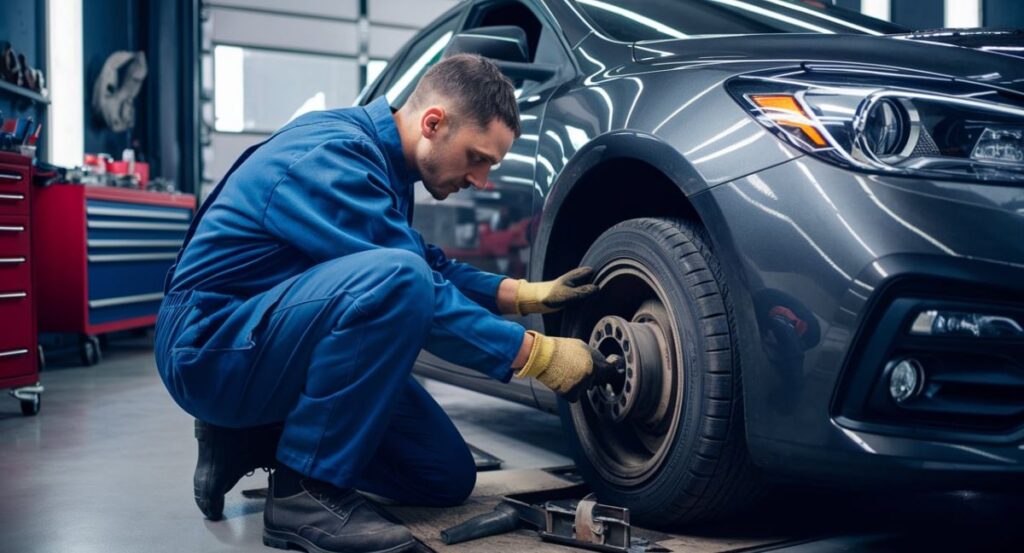
As car owners, we all share a unique bond with our vehicles and understand our pivotal role in keeping them in top condition. Regular maintenance is not just a cost but a responsibility we bear to ensure our cars are safe and reliable on the road.
This responsibility empowers us and makes us more knowledgeable about our vehicles. It’s a commitment we make to our safety and the safety of others on the road.
Do you hear loud rattling and growling noises while taking sharp turns and wonder what the cause is? It might be a wheel-bearing noise, but learning about and fixing it quickly is crucial if you’re unaware.
Driving with a faulty wheel bearing is not just a nuisance; it’s a potential safety hazard that could lead to a severe accident. Understanding how to identify and fix this issue before it escalates is crucial.
It makes us more cautious and aware on the road, preventing potential accidents and keeping you and your loved ones safe.
What Is A Wheel Bearing?
A wheel bearing is a small metal ball bearing. It consists of metal balls and a ring, also known as a race. The ball bearing is fitted inside the race and spins the wheel without friction.
This will allow the wheel to take turns efficiently. They are an integral part of every vehicle. Wheel bearings are connected to the axle. They will rotate at the end of the axle, which fits inside the wheel hub.
While lug bolts at the end of the wheel hub ensure the wheel stays in place, the wheel bearings bear the vehicle’s weight, making them a crucial safety component.
Wheel bearings are not just another part of your vehicle but integral to its performance and safety. Understanding and maintaining their role can significantly enhance your driving experience and safety, empowering you as a knowledgeable and in-control car owner. This knowledge gives you the confidence to handle any situation on the road.
Causes Of Wheel Bearing Noise
We now understand how dangerous it is to drive with faulty wheel bearings. Let’s discuss the causes of wheel bearing noise.
Poor Installation
If you recently replaced the wheel bearing or worked on the wheel of your car, this would be the reason behind the wheel bearing noise. If the mechanic who worked on your car didn’t put everything up according to the manufacturer’s instructions, you might damage the wheel bearing.
Addressing this issue as soon as possible is crucial to prevent further damage. The best course of action is to replace the wheel bearings altogether.
This underlines the importance of professional installation and adherence to the manufacturer’s instructions, as any deviation can lead to costly repairs and safety risks.
Driving On Uneven Terrain
Driving on uneven and bumpy roads, such as unpaved or poorly maintained surfaces, can put excessive pressure on the wheel bearings, leading to potential damage.
Initially, they will crack a bit, which will be unnoticeable, but if you continue to drive on rough terrain and bumpy roads, the problem will worsen.
If left unaddressed, the noise from a faulty wheel bearing can become increasingly loud and irritating, making it a clear sign that the issue needs to be fixed.
Water Exposure
Wheel bearings are combined with petroleum jelly to keep running smoothly. When you drive on wet roads or if the wheel is in too much contact with water, water gets into the bearings; it will be useless if water is mixed with jelly.
They can’t handle the friction and weight; the metal balls start rubbing against each other against the wipe-away jelly and make noise.
Driving Damaged Vehicle
If you’ve been in an accident and the wheel is damaged, there will be a wheel bearing noise, as the bearings are connected to most of the wheel and are highly susceptible to damage.
This becomes unnoticeable when they meet with an accident, and people look at the body and need to remember about the wheel bearings and how delicate they are.
Diagnosis Of Wheel Bearings

One of the most apparent reasons to find it if you have a faulty wheel bearing is to listen out for the noise. There are plenty of reasons to diagnose a defective wheel bearing. Here are the best methods.
Lift Your Car
To check for faulty wheel bearing noise, lift your car off the ground with the jack stand and hydraulic lift. Take a wheel and change the position slowly back and forth while keeping an eye out for movement.
You need to grab the tire and repeat the motion. There should be no movement or wobbling while or after you’ve done this.
You should perform this with every tire to know exactly where the wheel bearing is causing the problem. If there is any problem with the wheel, then the issue is a faulty wheel bearing.
Perform A Road Test
Another way to determine if the wheel bearing is faulty is by doing a road test. You’ll have to maneuver your car left while speeding and accelerating. Remember to find an empty road to perform the road test.
Take turns at low and moderate speeds. A failing wheel bearing often makes more noise when the load shifts; if the noise gets louder when turning in one direction and less in another direction, then presumably the issue is with the bearing on the side under less load during the noise increase.
Inspect For Physical Damage
When diagnosing a faulty wheel bearing, thoroughly inspecting it for physical damage is essential. Begin by removing the wheel and brake components to access the hub assembly. Look for any signs of grease leakage, which can indicate a compromised seal.
Grease leakage will lead to losing lubrication, increasing friction, and potential failure. Examine the bearing and hub assembly closely for visible cracks, dents, or corrosion.
Physical damage to the wheel bearing or its components indicates that replacement is necessary to ensure safe and smooth vehicle operation.
Check For Heat
After driving carefully, touch the wheel hub. A wheel with a failed bearing might be hotter than the others due to increased friction.
Check With Abs Light
If your abs light comes on, then there’s a chance that your bearings are having issues. The ABS light will indicate any problem with your car. All you need to do is listen to the noise of the bearing to ensure that the bearing is the problem.
Final Thoughts On Wheel Bearing Noise
Wheel bearings are a crucial part of the car. They can be damaged, and checking on them will make your drive smoother and more efficient. If you notice the wheel bearing problem, it’s time to grease or replace them.
It would help if you diagnosed the wheel bearing immediately. Driving with a faulty wheel bearing is risky, and your life is at risk each time you drive.
Protect the wheel bearings by avoiding bumpy roads and getting into deep water. This will ensure that your wheel bearing is safe and not damaged.
If you liked this and got value for it, don’t forget to share it with friends and family.
Related Articles:
